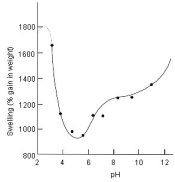Additional information on the dye - gelatin interaction
Bone gelatins are made by a process called Liming. This is treatment with Calcium Hydroxide. It leaves behind a residue of Calcium in the gelatin.
Early gelatins were Calcium rich and contained allyl thiourea, an emulsion sensitizer. Washing of emulsions was carried out by using water high in Calcium and Magnesium salts to minimize swelling.
Dyes used in Dye Transfer were sulfonic acid dyes supplied as the sodium or ammonium salt. The early DT process had preliminary steps intended to remove or reduce the existing calcium salts before imbibing the dye or they would react and precipitate in the coating, never to come out until treatment with a strong alkali solution. Therefore, often, depending on Calcium level, matrices would not completely transfer dyes and would build up dye in them to a certain level unless the Calcium and dye were removed somehow.
In addition to this, the early methods of making gelatins allowed a variation of isoelectric point over a fair range which influenced swell. In fact, companies such as Technicolor kept track of coatings as being hard, normal and soft based on the gelatin swell, not on silver imaging itself. The Isoelectric point is the point at which gelatin has its minimum swell.
Modern gelatins, since about 1950 on, are oxidized and deionized. They contain no allyl thiourea and no calcium. Emulsions contain no calcium. All bone gelatin today is carefully kept at an isoelectric point of about 4.5 - 4.8. These gelatins are supplied by Kind and Knox (Gelita brand), Rousselot, and Eastman Gelatin. I have used all 3 brands in my work and they are all very good. Eastman gelatin is the brand I am most familiar with followed by Rousselot. I have been told that Eastman gelatin may be bought from the Photographers Formulary AAMOF.
So, current modern gelatins are a very narrow and clean subset of the gelatins of yesteryear that were studied in the 40s and even 50s. They certainly give excellent results in the dye transfers that I have seen.
Pig gelatin has an isoelectric point of about 9, and is not currently in use at Eastman Kodak. They recently disposed of all old stocks of this type of gelatin. AFAIK, it was never used in DT materials.
Several black dyes were used in pan matrix films. One mentioned in the literature is Nigrosine.
I hope this clarifies some matters.
PE



